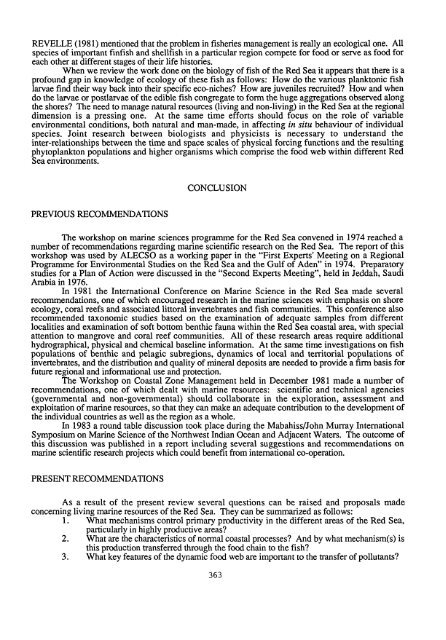139736eo.pdf (20MB) - Japan Oceanographic Data Center
139736eo.pdf (20MB) - Japan Oceanographic Data Center
139736eo.pdf (20MB) - Japan Oceanographic Data Center
- No tags were found...
Create successful ePaper yourself
Turn your PDF publications into a flip-book with our unique Google optimized e-Paper software.
REVELLE (1981) mentioned that the problem in fisheries management is really an ecological one. Allspecies of important finfish and shellfish in a particular region compete for food or serve as food foreach other at different stages of their life histories.When we review the work done on the biology of fish of the Red Sea it appears that there is aprofound gap in knowledge of ecology of these fish as follows: How do the various planktonic fishlarvae find their way back into their specific eco-niches? How are juveniles recruited? How and whendo the larvae or postlarvae of the edible fish congregate to form the huge aggregations observed alongthe shores? The need to manage natural resources (living and non-living) in the Red Sea at the regionaldimension is a pressing one. At the same time efforts should focus on the role of variableenvironmental conditions, both natural and man-made, in affecting in situ behaviour of individualspecies. Joint research between biologists and physicists is necessary to understand theinter-relationships between the time and space scales of physical forcing functions and the resultingphytoplankton populations and higher organisms which comprise the food web within different RedSea environments.PREVIOUS RECOMMENDATIONSCONCLUSIONThe workshop on marine sciences programme for the Red Sea convened in 1974 reached anumber of recommendations regarding marine scientific research on the Red Sea. The report of thisworkshop was used by ALECSO as a working paper in the “First Experts’ Meeting on a RegionalProgramme for Environmental Studies on the Red Sea and the Gulf of Aden” in 1974. Preparatorystudies for a Plan of Action were discussed in the “Second Experts Meeting”, held in Jeddah, SaudiArabia in 1976.In 1981 the International Conference on Marine Science in the Red Sea made severalrecommendations, one of which encouraged research in the marine sciences with emphasis on shoreecology, coral reefs and associated littoral invertebrates and fish communities. This conference alsorecommended taxonomic studies based on the examination of adequate samples from differentlocalities and examination of soft bottom benthic fauna within the Red Sea coastal area, with specialattention to mangrove and coral reef communities. All of these research areas require additionalhydrographical, physical and chemical baseline information. At the same time investigations on fishpopulations of benthic and pelagic subregions, dynamics of local and territorial populations ofinvertebrates, and the distribution and quality of mineral deposits are needed to provide a firm basis forfuture regional and informational use and protection.The Workshop on Coastal Zone Management held in December 1981 made a number ofrecommendations, one of which dealt with marine resources: scientific and technical agencies(governmental and non-governmental) should collaborate in the exploration, assessment andexploitation of marine resources, so that they can make an adequate contribution to the development ofthe individual countries as well as the region as a whole.In 1983 a round table discussion took place during the Mabahiss/John Murray InternationalSymposium on Marine Science of the Northwest Indian Ocean and Adjacent Waters. The outcome ofthis discussion was published in a report including several suggestions and recommendations onmarine scientific research projects which could benefit from international co-operation.PRESENT RECOMMENDATIONSAs a result of the present review several questions can be raised and proposals madeconcerning living marine resources of the Red Sea. They can be summarized as follows:1. What mechanisms control primary productivity in the different areas of the Red Sea,particularly in highly productive areas?2. What are the characteristics of normal coastal processes? And by what mechanism(s) isthis production transferred through the food chain to the fish?3. What key features of the dynamic food web are important to the transfer of pollutants?363
















